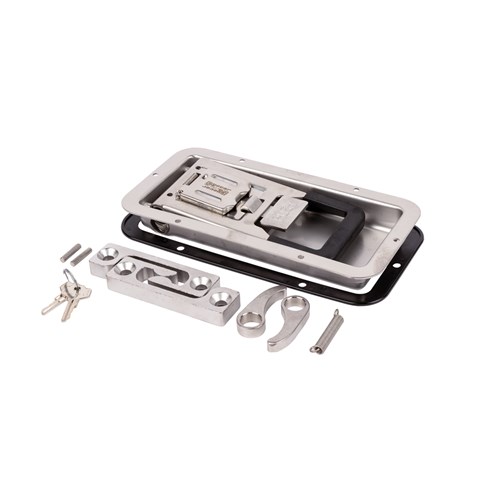When you’re designing or fabricating for heavy haulage, from service vehicles to fleet trailers, the right lock can make or break the reliability of your build.
Two of the most common options for enclosure hardware are compression locks and cam locks. While they look similar on the surface, their internal mechanisms and performance differ in ways that matter for long-term durability, vibration resistance, and compliance.
Here’s how they compare and when each one makes the most sense for OEM and fabrication applications.
1. The Fundamentals: Cam vs Compression
Cam Locks
Cam locks are the classic choice, a simple rotating latch mechanism that secures panels and doors in one smooth motion.
They’re quick to install, cost-effective, and available in multiple offsets and cam lengths to suit different enclosure depths.
Best suited for:
• General storage compartments
• Internal access panels
• Low-vibration environments

Compression Locks
Compression locks go one step further. They don’t just latch, they pull the door tight against the frame, compressing the seal and reducing vibration.
That extra motion makes them ideal for trailers, service bodies, and mobile equipment where dust, moisture, and constant movement are a given.
Best suited for:
• Ute and truck bodies
• Trailer doors
• Power boxes and mobile enclosures
.png)
2. Why Compression Locks Lead in Heavy Haulage
In heavy transport, vibration and weather exposure are constant challenges.
Compression locks excel because they:
• Maintain consistent seal pressure to prevent dust and water ingress
• Reduce rattling and wear from road vibration
• Improve noise reduction for high-use doors
• Help achieve IP-rated sealing when used with rubber gaskets
The result: fewer service issues, longer hardware life, and a more premium end-user experience.
3. When Cam Locks Still Make Sense
Cam locks shouldn’t be discounted. For low-impact or interior use, they’re often the most efficient option.
They:
• Offer a simple mechanical solution that’s easy to replace or retrofit
• Cost less than compression locks, making them ideal for large-scale production
• Are available in multi-keyed or keyed-alike systems for controlled access across multiple units
Many OEMs use cam locks across internal compartments while fitting compression locks on external panels, striking a balance between cost and performance.
4. Material and Finish Considerations
For heavy haulage, material choice is just as important as mechanism type:
Material
|
Ideal Use
|
Benefits
|
| Stainless steel |
External or high-exposure areas |
Corrosion-resistant, long lifespan |
| Zinc alloy / chrome plated |
Internal compartments |
Cost-effective and durable |
| Black powder coat |
Fleet or branded builds |
Clean, low-reflective finish |
5. Compliance and Fitment
Heavy haulage equipment must meet ADR and ISO vibration standards, particularly around sealing and load restraint.
Using compression locks with compliant sealing profiles, gaskets, and hinges ensures enclosures meet IP ratings and maintain structural integrity over time.
UES provides complete hardware systems — locks, hinges, seals, and struts — engineered to work together for consistent fit and compliance.
Final Word
Both compression and cam locks have their place in heavy haulage design.
If your builds face high vibration, dust, or moisture, compression locks deliver superior sealing and reliability.
For lighter or internal applications, cam locks remain a simple and cost-effective solution.
At UES, we supply both, tested, compliant, and backed by decades of experience in heavy vehicle hardware.
→ Explore the UES Lock Range for OEMs and Fabricators